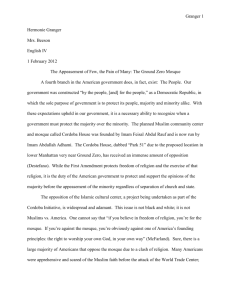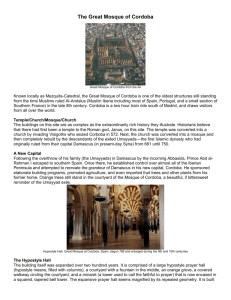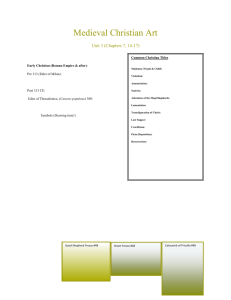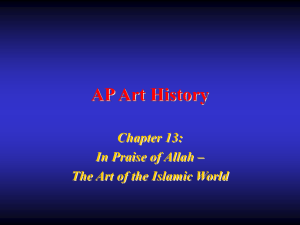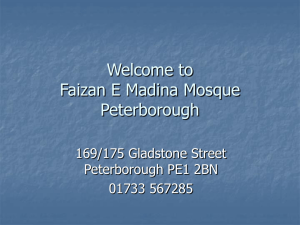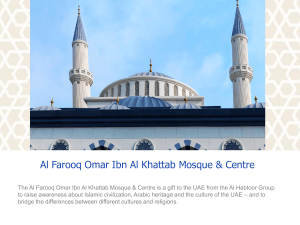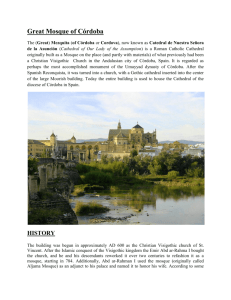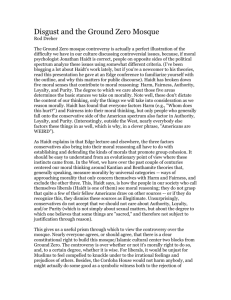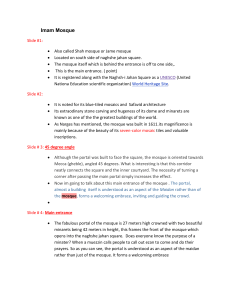Ctime663_Mosque_Cathedral_of_Cordoba
advertisement
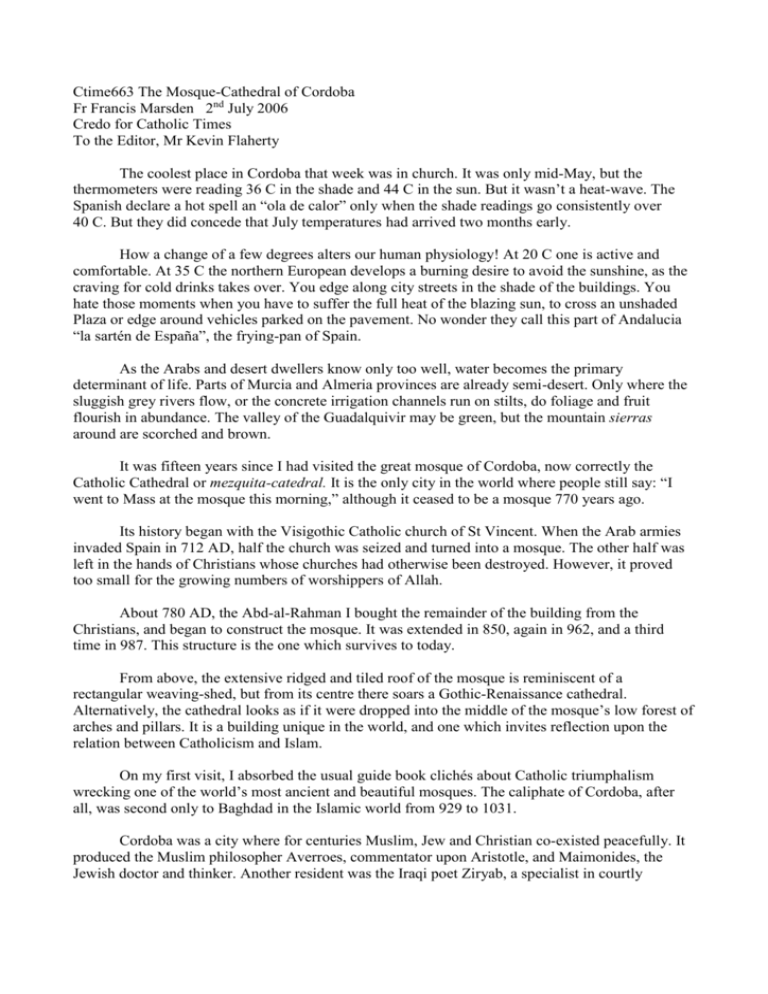
Ctime663 The Mosque-Cathedral of Cordoba Fr Francis Marsden 2nd July 2006 Credo for Catholic Times To the Editor, Mr Kevin Flaherty The coolest place in Cordoba that week was in church. It was only mid-May, but the thermometers were reading 36 C in the shade and 44 C in the sun. But it wasn’t a heat-wave. The Spanish declare a hot spell an “ola de calor” only when the shade readings go consistently over 40 C. But they did concede that July temperatures had arrived two months early. How a change of a few degrees alters our human physiology! At 20 C one is active and comfortable. At 35 C the northern European develops a burning desire to avoid the sunshine, as the craving for cold drinks takes over. You edge along city streets in the shade of the buildings. You hate those moments when you have to suffer the full heat of the blazing sun, to cross an unshaded Plaza or edge around vehicles parked on the pavement. No wonder they call this part of Andalucia “la sartén de España”, the frying-pan of Spain. As the Arabs and desert dwellers know only too well, water becomes the primary determinant of life. Parts of Murcia and Almeria provinces are already semi-desert. Only where the sluggish grey rivers flow, or the concrete irrigation channels run on stilts, do foliage and fruit flourish in abundance. The valley of the Guadalquivir may be green, but the mountain sierras around are scorched and brown. It was fifteen years since I had visited the great mosque of Cordoba, now correctly the Catholic Cathedral or mezquita-catedral. It is the only city in the world where people still say: “I went to Mass at the mosque this morning,” although it ceased to be a mosque 770 years ago. Its history began with the Visigothic Catholic church of St Vincent. When the Arab armies invaded Spain in 712 AD, half the church was seized and turned into a mosque. The other half was left in the hands of Christians whose churches had otherwise been destroyed. However, it proved too small for the growing numbers of worshippers of Allah. About 780 AD, the Abd-al-Rahman I bought the remainder of the building from the Christians, and began to construct the mosque. It was extended in 850, again in 962, and a third time in 987. This structure is the one which survives to today. From above, the extensive ridged and tiled roof of the mosque is reminiscent of a rectangular weaving-shed, but from its centre there soars a Gothic-Renaissance cathedral. Alternatively, the cathedral looks as if it were dropped into the middle of the mosque’s low forest of arches and pillars. It is a building unique in the world, and one which invites reflection upon the relation between Catholicism and Islam. On my first visit, I absorbed the usual guide book clichés about Catholic triumphalism wrecking one of the world’s most ancient and beautiful mosques. The caliphate of Cordoba, after all, was second only to Baghdad in the Islamic world from 929 to 1031. Cordoba was a city where for centuries Muslim, Jew and Christian co-existed peacefully. It produced the Muslim philosopher Averroes, commentator upon Aristotle, and Maimonides, the Jewish doctor and thinker. Another resident was the Iraqi poet Ziryab, a specialist in courtly refinement, who popularised what is now our normal sequence of courses at meals: first the soup, then the main course, then the dessert. However, this tolerant entente cordiale was badly damaged in the eleventh and twelfth centuries by the zealot Almoravids and Almohadars. Qu’ranic rigorists, they founded pious madrassas in Morocco to prepare earnest jihadis to cross to al-Andalus and wage holy war against the kuffir, the unbelieving Jews and Christians. Once Fernando III el Santo reconquered Cordoba from the Arabs in 1236, the mosque was immediately turned back into a Catholic church and rededicated to the Assumption of Our Lady. Entering from the forecourt of the Patio de los Naranjos (the orange trees) the light intensity falls to a fraction of that outside. One finds oneself in a forest of columns, 18 naves wide and 17 naves deep, which rise to row upon row of horseshoe-shaped arches, striped alternately cream and russet. When it was an Islamic place of worship, many side doors were open, allowing more light to permeate the mystical gloom. Ticket control now necessitates only two open doors. Many of the original entrances have been blocked and converted into Christian side chapels. Occasionally the vaults have small cupolas with roof lights, allowing shafts of light to fall diagonally into the forest of stone arches. The mosque exerts a strong geometrical fascination. From any standpoint within, the rows of columns and arches recede into the distant obscurity in eight directions– along the four cardinals and the four diagonals. In this maze of pillars and arcades one easily loses any sense of direction. In the original plan, the only distinguished section was the mihrab, the richly decorated niche indicating the direction of prayer. Oddly, this does not face south east to Mecca, but due south, an “error” which subsequent rebuildings and extensions never corrected. A wider zone of double spaced columns leads the eye to the three ornamental arches before the mihrab, where the caliph was arrayed in splendour as the imam or mufti led the prayers. It comes as a shock, therefore, to stumble suddenly into the bright light of the soaring cathedral in the middle, high Gothic shooting up 40 metres, compared to the 14 metre height of the mosque. A profusion of baroque art greets the eyes, splendour in glass and wood and stone and paint. No longer the mosque’s austere restraint in decoration, or the simple repeated Qu’ranic inscriptions and geometrical designs around the mihrab, but luxuriant vaulting, portraits of the saints, statues of the evangelists, stained glass, choir stalls engraved with over one hundred episodes from the lives of Christ and Mary, the saints and the prophets. The contrast between the two religions is startling. Islam, earth-bound, repetitive in design, eschewing the human form, the religion of a book, man humbled and in semi-darkness, confused and without a clear sense of direction. Catholicism, the bursting in of the Incarnation and Redemption from above, man’s response soaring to the heavens, the raising of the human form to share divinity. Light and space and splendour. In a word, glory. Whether this stunning contrast fascinates you, or whether you regard it as cultural vandalism, the man to praise or blame is Don Alonso Manrique. About 1520 he arrived in Cordoba as the newly appointed bishop. Having travelled widely in Europe and visited many Gothic masterpieces, he was sorely disappointed when he found that his “cathedral” was but a slightly adapted section of the “Moorish oratory”, with a single line of columns removed to afford a broader “nave”, and walls to divide it from the surrounding space. He felt this did not do justice to the importance of his ancient see. He had less respect than his predecessors for Arab architecture. He determined to erect a splendid Renaissance church exactly in the centre of the old mosque. The canons opposed him. The city council opposed him. So he appealed to the Emperor Charles V, far away in Vienna, who was preoccupied fighting the French and cursorily granted his request. After all, why should a bishop not build a new cathedral if he needed it? The whole central zone of the mosque was swiftly laid low, and a cathedral in the form of a Latin cross began to rise anew in its midst, far exceeding the dimensions of its reluctant fosterparent, like a giant cuckoo in a nest. It was oriented to the east, cutting at right angles across the original orientation of the mosque to the south, to the mihrab. Three years later, Charles V was staying in Seville on the occasion of his marriage to his cousin Dona Isabel of Portugal. He paid a brief visit to Cordoba, where on beholding the building site for the new cathedral, he rued his hasty assent: “Had I known what this was, I would not have allowed it to reach the ancient part. You have ruined that which was unique in the world, to build something which could be found anywhere.” This most Christian Emperor was not inimical to Muslim architectural achievements, nor uncritical of culturally insensitive Catholics. His grandparents were the crusading Reyes Católicos, Fernando and Isabella, who gloriously concluded eight centuries of Reconquista when in 1492 they conquered Granada, the last Muslim kingdom of Spain. Even they lovingly adopted the fabulous Moorish palace of the Alhambra as their favourite residence. The mosque’s minaret too was incorporated into a gigantic baroque bell-tower. It took until 1766 to complete the cathedral, so Charles V never saw the finished product. In an unintended way, Bishop Manrique left to the world a still unique and even more unusual building – a mosquecathedral, with 54 side chapels lining its walls, and Renaissance vaults soaring from its low forest of arches and columns. Each complements the other, although neither may please the purist. And it leaves us with the question, can Islam function as a preparation for belief in a Trinitarian God, instead of an obstacle in the path of Divine Revelation?
